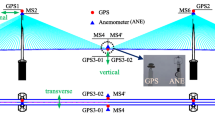Abstract
In this study, the use of ARIMA model coefficients extracted from the response of global thermal deformation, which can be acquired by the GPS monitoring, was proposed for the structural change monitoring of the long-span bridge. The daily periodic air temperature change causes the characteristic global thermal deformation, which is suitable to be acquired by the GPS in the long-span cable-stayed bridge. The pattern of this global thermal deformation was then expected to have sensitivities to changes on global structural properties. The procedures of feature extraction based on the ARIMA model estimation and the Mahalanobis distance comparison were presented, and their applicabilities were verified both by the numerical study and by the application to actual GPS monitoring data. In the numerical study, a FE model of a cable-stayed bridge was constructed, and the time-series displacements under the periodic temperature load were obtained with some cases of structural conditions by varying the boundary conditions and the cable tensions. The procedures of feature extraction and comparison were then applied to the obtained displacement time-series. In the results, the Mahalanobis distance of feature vector, which was configured by estimated AR and MA coefficients, showed significant changes both in the two cases of boundary condition and stayed-cable tension changes. The procedure was then applied to year-round GPS data acquired in the actual cable-stayed bridge. It was shown that the Mahalanobis distance comparison could provide proper assessment to the structural changes that was consistent with the actual structural condition.












Similar content being viewed by others
References
Cross EJ, Koo KY, Brownjohn JMW, Worden K (2010) Long-term monitoring and data analysis of the Tamar bridge. Mech Syst Signal Process 35(1–2):16–34
Zhou Y, Sun L, Peng Z (2015) Mechanisms of thermally induced deflection of a long-span cable-stayed bridge. Smart Struct Syst 15(3):505–522
Rolands K, Prakash K, Bill H (2015) Long-term structural health monitoring of the Cleddau bridge: evaluation of quasi-static temperature effects on bearing movements. Struct Infrastruct Eng 12(10):1342–1355
Fujino Y, Murata M, Okano S, Takeguchi M (2000) Monitoring system of the Akashi Kaikyo Bridge and displacement measurement using GPS. In: Nondestructive Evaluation of Highways, Utilities, and Pipelines IV, 3995. International Society for Optics and Photonics, pp 229–237
Celebi M (2000) GPS in dynamic monitoring of long-period structures. Soil Dyn Earthq Eng 20(5–8):477–483
Kaloop MR, Li H (2009) Monitoring of bridge deformation using GPS technique. KSCE J Civ Eng 13(6):423–431
Le VH, Nishio M (2015) Time-series analysis of GPS monitoring data from a long-span bridge considering the global deformation due to air temperature changes. J Civ Struct Health Monitor 5(4):415–425
Sohn H, Farrar CR (2001) Damage diagnosis using time series analysis of vibration signals. Smart Mater Struct 10(3):446–451
Kaloop MR, Hussan M, Kim D (2019) Time-series analysis of GPS measurements for long-span bridge movements using wavelet and model prediction techniques. Adv Space Res. https://doi.org/10.1016/j.asr.2019.02.027
Omenzetter P, Brownjohn JMW (2006) Application of time series analysis for bridge monitoring. Smart Mater Struct 15(1):129–138
Shi H, Worden K, Cross EJ (2019) A cointegration approach for heteroscedastic data based on a time series decomposition: an application to structural health monitoring. Mech Syst Signal Process 120:16–31
Hamilton JD (1994) Time series analysis. Princeton University Press, Princeton
Vikas AC, Prashanth MH, Indrani G, Channappa TM (2013) Effect of cable degradation on dynamic behavior of cable stayed bridges. J Civ Eng Res 3(1):35–45
Worden K, Manson G, Fieller NR (2000) Damage detection using outlier analysis. J Sound Vib 229(3):647–667
Author information
Authors and Affiliations
Corresponding author
Additional information
Publisher's Note
Springer Nature remains neutral with regard to jurisdictional claims in published maps and institutional affiliations.
Rights and permissions
About this article
Cite this article
Le, H.V., Nishio, M. Structural change monitoring of a cable-stayed bridge by time-series modeling of the global thermal deformation acquired by GPS. J Civil Struct Health Monit 9, 689–701 (2019). https://doi.org/10.1007/s13349-019-00360-9
Received:
Accepted:
Published:
Issue Date:
DOI: https://doi.org/10.1007/s13349-019-00360-9




